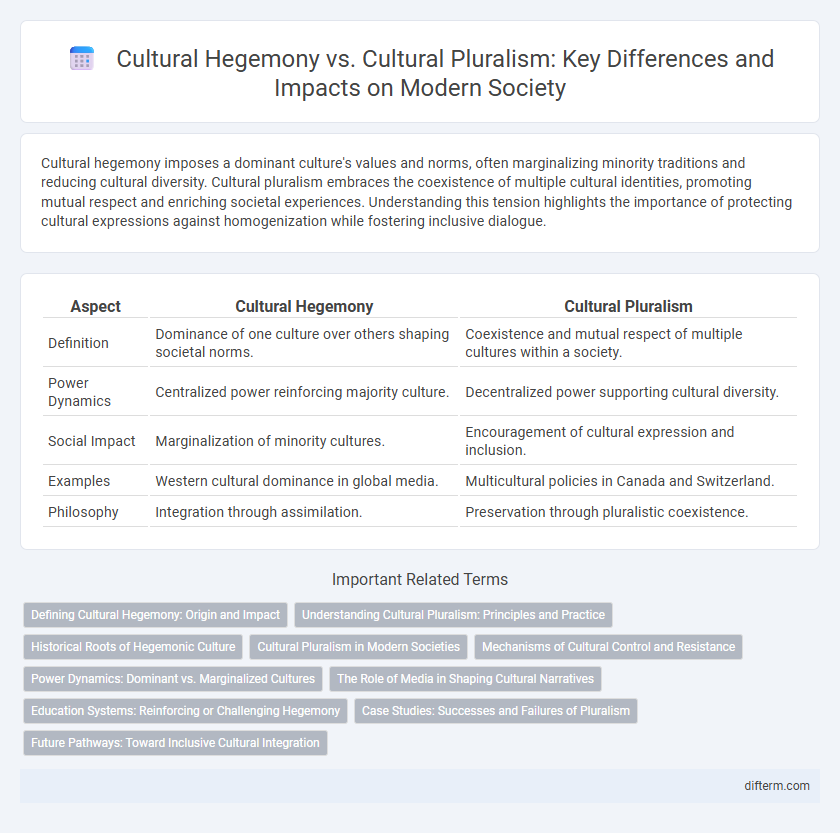Cultural hegemony imposes a dominant culture's values and norms, often marginalizing minority traditions and reducing cultural diversity. Cultural pluralism embraces the coexistence of multiple cultural identities, promoting mutual respect and enriching societal experiences. Understanding this tension highlights the importance of protecting cultural expressions against homogenization while fostering inclusive dialogue.
Table of Comparison
| Aspect | Cultural Hegemony | Cultural Pluralism |
|---|---|---|
| Definition | Dominance of one culture over others shaping societal norms. | Coexistence and mutual respect of multiple cultures within a society. |
| Power Dynamics | Centralized power reinforcing majority culture. | Decentralized power supporting cultural diversity. |
| Social Impact | Marginalization of minority cultures. | Encouragement of cultural expression and inclusion. |
| Examples | Western cultural dominance in global media. | Multicultural policies in Canada and Switzerland. |
| Philosophy | Integration through assimilation. | Preservation through pluralistic coexistence. |
Defining Cultural Hegemony: Origin and Impact
Cultural hegemony, a concept developed by Antonio Gramsci, refers to the dominance of a single cultural worldview that shapes societal values, norms, and beliefs, maintaining the power of ruling classes. Originating in Marxist theory, it explains how cultural institutions, such as media, education, and religion, perpetuate social control by normalizing the dominant ideology. The impact of cultural hegemony results in the marginalization of alternative cultural perspectives, limiting cultural diversity and reinforcing systemic inequalities.
Understanding Cultural Pluralism: Principles and Practice
Cultural pluralism recognizes the coexistence of diverse cultural groups within a society, promoting mutual respect and equal participation without imposing a dominant culture. It fosters dialogue, inclusivity, and the preservation of distinct cultural identities while encouraging shared values and social cohesion. Effective practice of cultural pluralism involves policies that support minority rights, intercultural education, and representation in political and social institutions.
Historical Roots of Hegemonic Culture
Cultural hegemony, rooted in Antonio Gramsci's theory, describes the domination of a culturally diverse society by a ruling class's worldview, which becomes the accepted cultural norm. This dominance historically emerged through colonialism, imperialism, and the global spread of Western ideologies, marginalizing indigenous and minority cultures. In contrast, cultural pluralism promotes the coexistence and mutual respect of diverse cultural groups, challenging hegemonic narratives and advocating for inclusive cultural representation.
Cultural Pluralism in Modern Societies
Cultural pluralism in modern societies promotes the coexistence of diverse cultural groups maintaining their unique identities while contributing to a shared social fabric. This approach fosters mutual respect, inclusivity, and equal participation in political, economic, and social systems, enhancing social cohesion and innovation. Emphasizing multicultural policies and intercultural dialogue supports sustainable development and counters the dominance of cultural hegemony.
Mechanisms of Cultural Control and Resistance
Cultural hegemony employs mechanisms of cultural control such as media dominance, educational curricula shaping, and institutional norms to perpetuate the values and beliefs of the ruling class. Cultural pluralism fosters resistance by promoting diverse narratives, local traditions, and grassroots movements that challenge homogenizing forces and assert minority identities. These opposing dynamics reveal how cultural power is negotiated through symbolic practices and social institutions.
Power Dynamics: Dominant vs. Marginalized Cultures
Cultural hegemony consolidates power by allowing dominant cultures to impose their values, norms, and beliefs across societal institutions, often marginalizing minority groups and suppressing alternative cultural expressions. This power dynamic perpetuates social inequalities by normalizing the dominant culture as universal and superior, thereby limiting the visibility and influence of marginalized cultures. In contrast, cultural pluralism promotes the coexistence and equal recognition of diverse cultural identities, challenging hegemonic power structures and fostering mutual respect and inclusivity within society.
The Role of Media in Shaping Cultural Narratives
Media plays a crucial role in shaping cultural narratives by either reinforcing cultural hegemony or promoting cultural pluralism. Through dominant media channels, cultural hegemony often perpetuates mainstream ideologies and marginalizes alternative voices, shaping public perception and societal norms. Conversely, pluralistic media platforms provide space for diverse cultural expressions, encouraging dialogue and inclusion that challenge dominant narratives.
Education Systems: Reinforcing or Challenging Hegemony
Education systems often serve as a battleground between cultural hegemony and cultural pluralism, where curricula and pedagogical practices either reinforce dominant cultural narratives or promote diverse perspectives. Schools that prioritize a singular cultural framework tend to perpetuate existing power structures by marginalizing minority histories and voices. Conversely, incorporating multiple cultural viewpoints within education fosters critical thinking and challenges hegemonic norms by validating the experiences of diverse communities.
Case Studies: Successes and Failures of Pluralism
Cultural pluralism thrives in cases like Canada's multicultural policy, which successfully promotes diverse cultural expressions while fostering social cohesion and reducing ethnic tensions. Contrastingly, failures in pluralism appear in countries such as Belgium, where linguistic and cultural divisions have fueled political instability and persistent societal fragmentation. These case studies highlight the critical balance between recognizing cultural diversity and maintaining a unified national identity to achieve sustainable pluralistic success.
Future Pathways: Toward Inclusive Cultural Integration
Future pathways for cultural integration emphasize embracing cultural pluralism to counteract the dominance imposed by cultural hegemony, fostering equitable representation and mutual respect among diverse cultural groups. Policies promoting inclusive education, intercultural dialogue, and participatory governance enhance social cohesion and empower marginalized communities to contribute to a shared cultural landscape. Advancing digital platforms and globalization dynamics can support pluralistic narratives, ensuring cultural diversity thrives within integrated societies.
Cultural Hegemony vs Cultural Pluralism Infographic

 difterm.com
difterm.com